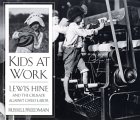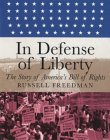|


Analysis
Analysis of
Kids at Work: Lewis
Hine and the crusade against child labor
&
In Defense of
Liberty: The story of America's Bill of
Rights
Kids at Work: Lewis Hine and the crusade against child
labor
In Kids at Work: Lewis Hine and the crusade against child
labor,
haunting photographs of elementary-aged children do nothing but
increase the
reader's shock as story after story unfolds of children who should have
been in
elementary school, but instead were working at manual labor jobs during
the
early 1900's. A teacher and amateur photographer named Lewis Hine
was
hired by the National Child Labor Committee (NCLC) to photograph these
children
as they worked in the hopes that this would call attention to their
plight and
help to end child labor. Although federal regulation of child
labor did
not occur until two years before Hine's death in 1940, it was his
pictures that
helped to keep the issue at the forefront of America's consciousness
until a
law was finally passed.
Freedman effectively tells a story within a story in Kids at Work.
Chapter one gives the reader a brief introduction to the issue of child
labor,
while chapter two gives a relatively detailed biography of Lewis Hine's
life up
to the point he was employed by the NCLC. The following chapters
simultaneously tell the life of Hine and the story of child laborers as
they
recount Hine's work in documenting the young workers in pictures.
Mary
Burns, a reviewer for Horn Book Magazine, states "The narrative not
only
documents the abuses of the times but also traces the chronology of
Hine's
development as a crusader, his personal struggles, his techniques for
outwitting the owners and managers who wanted to conceal their inhuman
practices, and his final years of poverty when, at the end of the Great
Depression,
he was forced to apply for public assistance. The account has
about it
the quality of a modern epic whose hero, although scorned by fortune
and tried
by adversity, triumphs as a visionary." (Burns 1994)
Freedman uses excerpts from primary sources such as Hine's reports to
NCLC and
letters to friends that allow readers a first hand glimpse into his
world. Next to a picture of a mother and four young children
working
diligently to make artificial flowers by the light of a kerosene lamp,
Hine reports
that the mother said to him "Flowers is cheap work now, too cheap work
for
anybody but us." (pp.16-17) The beauty of the children's faces
seems
to stand out in Hine's pictures even more as they stand beside large
machines
that seem as if they could swallow them whole.
Freedman himself has stated that he hopes that his books will be
enjoyed by
readers of all ages (Sutton 2002), and Kids at Work did not go
unnoticed
by reviewers of literature for adults. In Monthly Labor Review,
Robert Senser (1995) commented, "Though written for children, Kids
at
Work offers useful reminders to adults about some grim chapters in
American
history. It also suggests a powerful lesson for today: that
all of
us should open our eyes to the still-thriving exploitation of
children."
A bibliography, picture credits, and an index are included at the
conclusion of
the book.
In Defense of Liberty: The story of America's Bill of Rights
By beginning with a brief story that outlines what could happen to
a
citizen if there were no Bill of Rights, Freedman subtly makes his case
for why
knowing about the Bill of Rights should be important to every
American.
After a brief history of how the Bill of Rights came to be written, the
following chapters detail each of the first Ten Amendments. Brief
summaries of the Thirteenth, Fourteenth, and Fifteenth Amendments are
also
included. The conclusion contains a picture of the original
handwritten
Bill of Rights along with notes, an index of Supreme Court cases, a
selected bibliography,
and an index.
"Careful scholarship" (Litherland 2004) noted by a reviewer is
evident in the many details of the text. For each Amendment,
Freedman
gives history that explains why the forefathers included the Right, and
then
cites real world examples of how it is applied in our society.
Historical
court cases along with modern challenges or invocations of each Right
not only
allow the reader to see how the Amendment has applied in the past but
also its
applications today. For example, in explaining the Sixth and
Seventh
Amendments, which give the right to a fair trial (pp.115-128), Freedman
is able
to show the evolution of this Amendment across time through real-world
examples. From challenges to the Amendment that changed trial
juries from
being comprised of white males to people of both genders and all races
to
defendants who spoke up and demanded that they be given a court
appointed
lawyer, Freedman translates the high-brow language of America's
founders into
readable stories that put civil rights in context. Black and
white
reproductions of historical artwork and contemporary pictures further
illustrate how the Bill of Rights has been applied in our society.
When the topic is something as hotly debated as the Bill of Rights,
questions
arise about the author's objectivity. Although he is able to give real
world
examples that show the different facets of each Amendment, Freedman
himself
admits that his own biases bleed into his writing. In an
interview for
Book Links magazine, Freedman said, "I do have values and opinions and
they may inevitably have an effect on my approach to a book and my
attitude
toward the subject, but I make a conscious effort to include both
sides.
I don't think it's possible to be completely objective. I think
this
comes out in how certain things are emphasized. For example, in
the
chapter about gun control, I tried to give both sides, but I don't
think it's
neutral. Why would I spend all that time writing this book if I
didn't
have an opinion about the value of the Bill of Rights?" (Giorgis and
Johnson 2004)
The two books side-by-side
When comparing these two books, it quickly becomes apparent that
Freedman
meticulously researched both subjects. Both include citations to
works in
their bibliographies and photos that cover a range of the books'
topics.
The photos in each book also complement and extend the text.
Although
neither book could be considered an exhaustive work, both go into great
detail
and do not spare their young audiences the harsher facts of their
subject matter.
While these books have many things in common, there are also some
elements that
differ. Kids at Work has a story line with a beginning,
middle,
and end. Readers are introduced to Lewis Hine and the issue of
child
labor, the majority of the book follows his life as he documents the
atrocities
of the issue, and the conclusion reveals the sad end of Hine's life and
the
triumph of federal legislation that bans children from the
workplace. In
contrast, In Defense of Liberty tells the facts about a
historical
document and leaves the reader knowing that the Bill of Rights is a
living
document and more could be written at a later date.
Because Kids at Work recounts the life of one man, Freedman is
able to
go into great depth regarding Hines history, family, thoughts,
financial
situation, etc. Readers only see quick snapshots of people's
lives as
they relate to the Bill of Rights in In Defense of Liberty.
Although one of these works focuses on a life and the other focuses on
a
document, both reveal the commitment of their author, Russell
Freedman.
His commitment to accuracy in his work is seen in research and
documentation,
and his commitment to children's literature is seen in the fact that
his books
are able to nimbly convey complex subject matter in a way that is
understandable to children without a hint of condescension.
|

